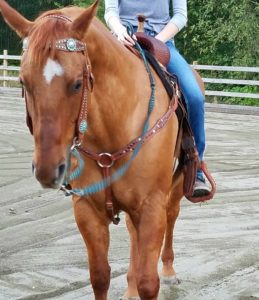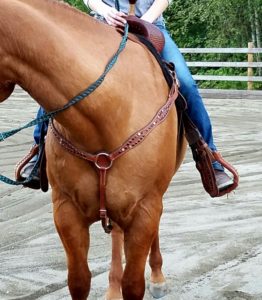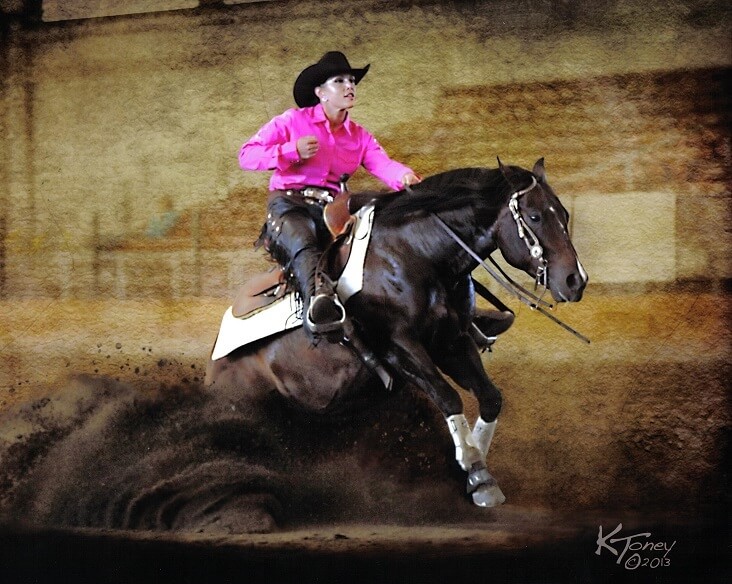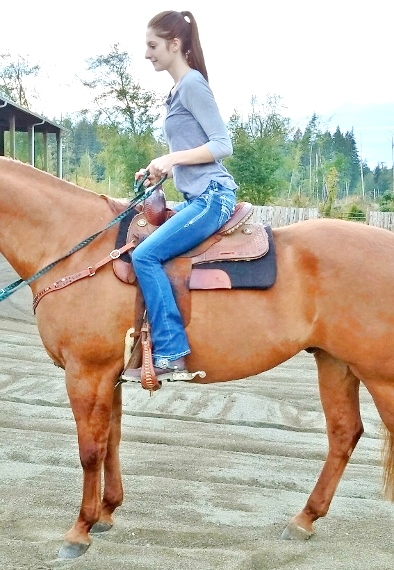Solving the Downward Spiral of Fear
by Deanna Lally

As herd animals, horses are sensitive to emotions, personalities, and energy. This plays a large role in the horse/human relationship. Many times I’ve seen a horse that is normally calm become nervous and excited when an unsure or worried rider steps aboard. People often ask why this happens; the answer is twofold.
Let’s first examine the horse’s psychology in regard to its role in the herd. No horse has an unchangeable role. An alpha horse is only alpha until a more dominant leader takes that role away. Just the same, a submissive horse becomes dominant in the presence of a weaker animal.

When it comes to the horse/human herd, a worried or unsure handler immediately puts a submissive horse into a dominant role; without an alpha present, the horse becomes alpha. This is how the herd mentality works. Therefore, when the anxious rider steps aboard, the horse feels that there is no leader present and he becomes the leader. He now must make the decisions and take action.
The second part of the answer is directly related to energy. Now that the horse is the leader, he’s assessing his environment more alertly so that he can react and direct his herd. (Picture an actual herd of horses—the alpha always oversees and is often aware of situational changes before his subordinates.) Now, rather than being a patient subordinate listening to the calm direction of the alpha herd-mate in the saddle, the horse follows his own senses keenly. He feels the nervous energy of the uncertain rider and, as a herd animal should, he reacts. There is something to be worried or excited about, is what the horse thinks and feels. This is what causes a horse who is normally well-trained and calm to become difficult to handle, spooky, or flighty with a nervous rider in the saddle. Energy is a tremendously powerful player in equestrian endeavors.

The remedy for these problems begins with altering the physiological details of the rider. No nervous rider has a relaxed body that moves fluidly with his or her horse. Physical tension coincides with psychological stress. To help alleviate and eventually eliminate nerve-related issues with your horse, a rider’s best chance is to begin addressing the physical symptoms of anxiety.
Most anxious riders don’t breathe in the calm manner they would sitting on their couch. So when you mount your horse, take deep breaths. Next, soften your spine and abdomen. Tension is carried directly from the brain, through your body, and then into your horse’s body as he feels you aboard him. Relax your thighs so you are not gripping around the horse excessively. Even wiggle your toes to make sure you’re not bracing in the stirrups.
Lastly, I tell riders to look around the arena casually. Every single nervous rider I’ve seen stares intensely at the back of their horse’s head. By doing so, the rider fails to send a message to the horse that says we are going here, and instead furthers the sensation to the horse that the person aboard is not in command.

I’ve often wondered if the “fear stare” that a scared rider focuses into the back of their horse’s head has deeper implications: Is it possible that the herd animal is made nervous by that intense stare because of prey-animal based instincts? All I know is that in 17 years as a trainer, I’ve seen dramatic differences in a horse’s state of calm when I can get an anxious rider to stop that intense stare, if nothing else. It’s amazing.
Here’s the best advice I can give to help deal with anxiety: find a trainer that can talk you down from the emotional skyscraper when you find yourself there. The trainer should have an ability to assess where you carry your stress, how you hear instruction, and take steps to resolve your physical issues first. Once the physical issues are in check, your horse will relax, and you can begin actual technical instruction and exercises.
I believe for the green beginner, anxious rider, and even advanced competing riders, 90% of my job is piecing together a mental game plan tailored to each individual’s specific way of thinking and reacting. The mechanical part of riding is the easier part, once the energy, emotions, and thoughts of the rider are correct and healthy.

Since 1999, trainer, breeder, and Western Horseman author Deanna Lally has cultivated a thoughtful program centered on a passion for building show horses that stay sound of body and mind. With equal dedication, she educates riders to become procient horsemen and champions in their own right. She and her non-pros continually make top placings at NRHA and AQHA shows throughout the nation. Deanna owns RLT3 Ranch LLC, a boarding/training facility in Lake Stevens, WA, where she stands champion AQHA stallion, Working For Chexs. Evaluations, demonstrations, lessons, training, and tours are available by appointment. Connect on Facebook or email [email protected].






